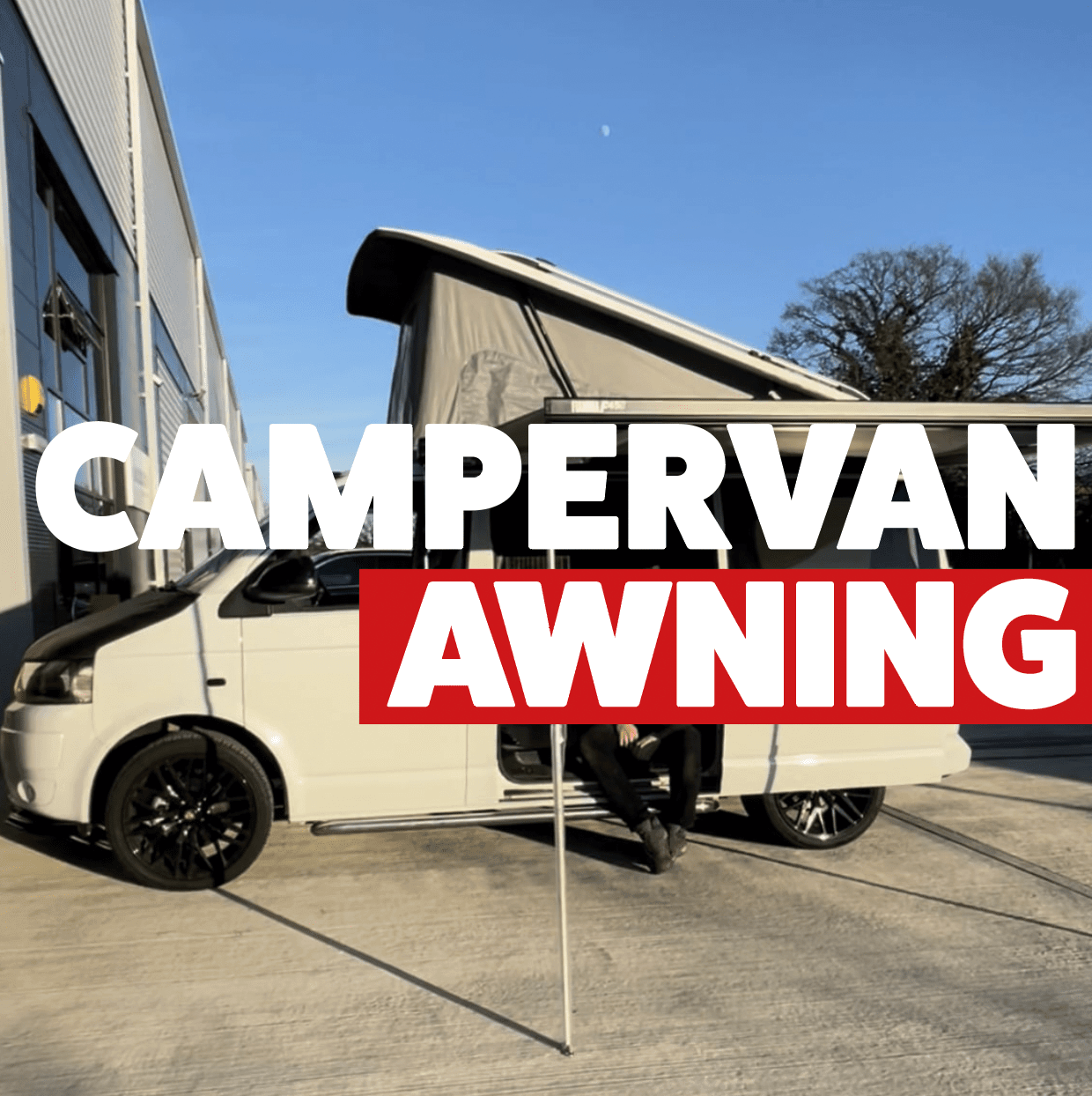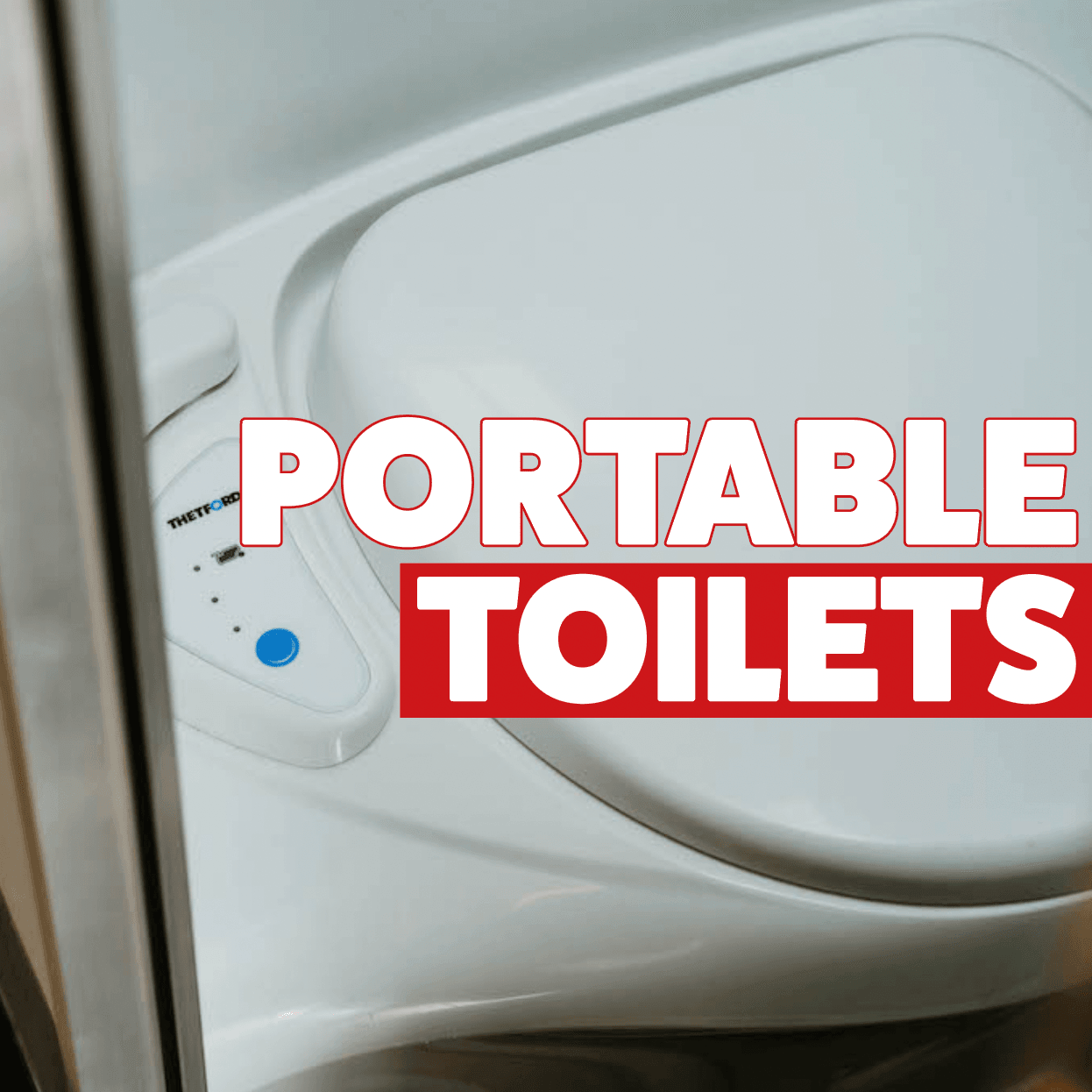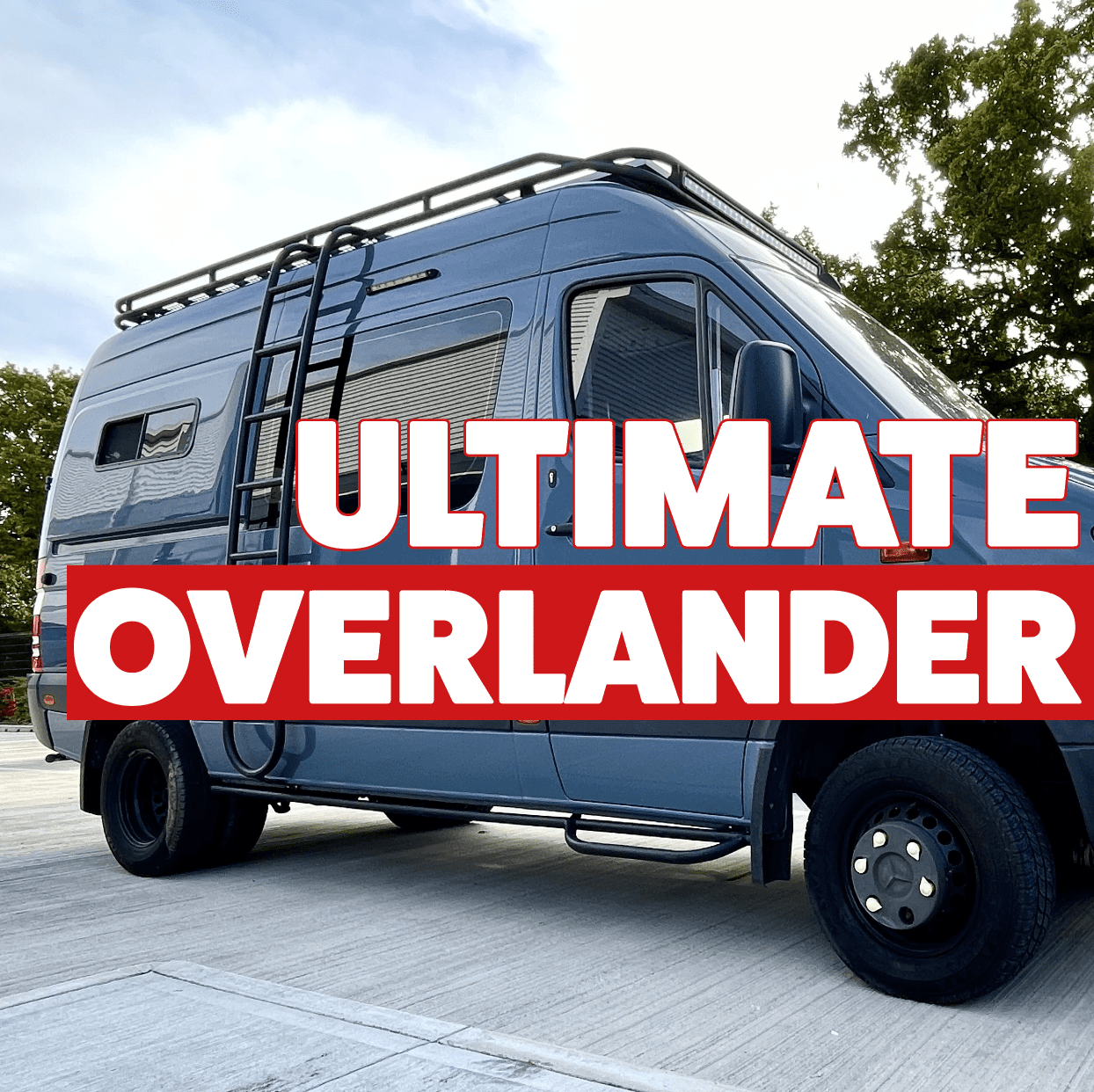When it comes to kitting out your campervan, one of the most important items to consider is your campervan awning.
Not only does a campervan awning provide shade and shelter from the elements, but it can also increase the livable space in your van. Which is important in smaller conversions like the VW Transporter.
A campervan awning offers more comfortable outdoor living space. It creates a shaded area where you can relax, cook, and drink a beer or two, without worrying about the sun or rain. An awning can be a great place to store outdoor gear, such as camping tables and muddy boots.
We know people also use the full tent awnings as a place for their dog to sleep at night. But keep in mind not all four legged friends will be convinced. My dog needs to sleep right next to me or she would bark all night - no awning bedroom for her!

What type of campervan awnings are available?
Traditional pole and canvas awnings
These types of awnings use poles and canvas to create a shelter. They are typically easy to set up and take down, and are available in a variety of sizes.
Inflatable awnings
These types of awnings use an inflatable structure to create a tent-like shelter. They’re quicker and easier to set up than traditional pole and canvas awnings, and can be inflated using an electric pump or by hand.
Inflatable awnings are becoming increasingly popular among campervan owners due to their ease of use and quick setup. Inflatable awnings can be set up in a matter of minutes, as they are inflated using an electric pump or by hand. They are also relatively lightweight and easy to transport, making them great for camping trips.
The inflatable structure provides added stability and wind resistance compared to traditional pole and canvas awnings. Inflatable awnings come in a variety of sizes and designs.
Wind Out Awnings
Wind out awnings are mounted on the side of the campervan and can be extended when in use and retracted when not in use by winding it out on a roll. They are also known as roll-out awnings or cassette awnings. One of the most popular wind out awnings is the Fiamma F45s, ideal for the VW Transporter.
They’re easy to use and can be put in and out quickly. They’re also typically more durable and weather-resistant than traditional pole and canvas awnings.
Wind-out awnings are typically made of a waterproof and UV-resistant fabric, which helps to provide shade and shelter from the sun and rain. They also usually have the option to attach additional side panel “walls” for added privacy.
Because they’re mounted on the side of the campervan, this frees up space inside the van as tent awnings come in pretty huge bags. When it comes to maintenance, wind-out awnings are relatively easy to keep clean.
Motorised Awnings
These types of awnings are controlled by a remote or an app and can be extended and retracted automatically. They are convenient and easy to use, but also tend to be more expensive than the others. They’re not something you see very often on VW Transporters.

How to attach an awning to a campervan
There are different ways to mount the different types of awnings.
Awning Rails / Combi Rails
For the tent awnings (inflatable or pole) you need to mount a combi rail to your van. We recommend the Vamoose Awning Rail, however there are a few different products on the market.
Once mounted, the awning rail allows you to feed any standard awning through the gap which connects the awning securely to your van. Combi rails are mounted to the van by drilling holes and using glue and sealant to secure. Mounting a combi rail is a permanent alteration to the vehicle.
Wind Out Awnings - like the Fiamma
Obviously the instructions vary between the different models. You’ll need to find out which mounting bracket you need for your vehicle type.
For the Fiamma F45s Awning you need to ensure you have the correct brackets.
Once you're ready to fit the awing. Clean the surface where the bracket is going to be mounted on your van. Mark the location, and set about drilling the holes. Secure the bracket on to the campervan. Make sure you test the awning by extending it out to test it is secure. Best to this at home, rather than at a campsite for the first time.
Can I install the campervan awning myself or should I get a professional to do it?
This is a difficult question to answer. Basically it comes down to how handy you are with tools. If you have experience with installing similar items on your campervan, you may be able to install the awning yourself.
It's important to carefully read the manufacturer's instructions and make sure you understand the process and have the necessary tools and equipment before attempting to install the awning.
Installing a campervan awning can be a complex process that involves drilling holes in the body of the van, so it's important to be sure of your abilities. This isn’t for the faint hearted. If you are not confident in your ability to install the awning correctly and safely, it may be best to hire a professional.

How to maintain a campervan awning and prevent mould
It’s important to take care of campervan awnings. They are generally very well made and can last years. However putting them away wet means they very quickly turn mouldy and end up in the bin.
Try not to put away awnings when they are wet. If you have to make sure you get them back out again when you get home and dry them off properly. Follow these steps to maintain your awning and prevent mould:
- Clean your awning with a mild soap and water solution, and rinse it off thoroughly. Be sure to remove any dirt, debris, or bird droppings that may have accumulated on the awning
- After cleaning, make sure to dry the awning thoroughly before storing it. This will help to prevent mould growth.
- When not in use, store the awning in a dry, cool place. Make sure it's completely dry before storing it
- Make sure to check for leaks in the awning, as water can seep in and cause mould to grow
- Inspect the awning regularly for mould growth, and address any mould issues as soon as they are detected
- Keeping the awning properly tensioned will help to prevent water from pooling on the surface, which can lead to mould growth
- Some products such as mould inhibitors can be used to help prevent mould growth on the awning fabric
- Don’t store the awning in damp places such as basements or garages
- If the awning has not been used in a while, remove the fabric and wash it separately to avoid mould growth
- Clean the awning's mechanisms, such as the rollers, to ensure they are functioning properly and not causing any problems.
How should I store my campervan awning when I’m not using it?
Properly storing your campervan awning when not in use is essential to ensure it lasts more than a season and to prevent damage. Before storing, make sure the awning is clean and dry.
Carefully fold the awning, making sure it is folded neatly and tightly to prevent wrinkles or creases. Place the folded awning in a waterproof and UV-resistant storage bag, this will help to protect it from the elements and prevent dirt and dust from getting on it.
Store the awning in a dry and cool place, and avoid storing it in damp places. Keep the awning off the ground, using a raised platform or store it on a shelf, to prevent moisture from seeping into the fabric.
Keep the awning away from direct sunlight, as the sun's UV rays can damage the awning fabric over time. Regularly inspect the awning while it's in storage to ensure that it's in good condition and that there are no issues.
If you haven’t used the awning for a few months over the winter, make sure you get it out for a test run at home. Better to find out there’s a problem when you're on your driveway, rather than out on the road.
Can awnings be used in all weather conditions?
Awnings can be used in a variety of weather conditions, but they may not be suitable for extreme weather such as heavy rain, high winds, or heavy snowfall.
Most awnings are made of waterproof and UV-resistant fabric, which helps to provide shelter and shade from the sun and light rain. However, they may not be able to withstand heavy rain or strong winds without becoming damaged. Inflatable awnings, for example, can be more susceptible to damage in high winds as they rely on the air pressure to maintain its shape.
During heavy rain or strong winds, it is best to retract the awning and secure it properly to prevent damage. In heavy snowfall, it is important to remove the awning or to support it properly to prevent the snow from accumulating and causing damage.
It's important to check the manufacturer's recommendations for the awning you have, as some awnings are designed for specific weather conditions and some may have limitations. It's also important to make sure you are aware of the weather forecast before setting up an awning and take necessary precautions if bad weather is expected.

Wildworx Campervan Awnings
A campervan awning is an essential item for any campervan owner, providing not just shade but also adding more living space. Wildworx can supply your campervan awning. We also offer a professional fitting service from our workshop in Alcester, Warwickshire.
Our other blogs relating to VW Campervan Awnings:
| Vamoose Awning Rail |
| VW T5 Awning Rail |
| VW T6 Awning Rail |
| How to choose a camper awning |
| What you need to know before buying a campervan awning |
| Fiamma F45s: Our Guide |
Get in touch if you have any questions, our team would be happy to help. Alternatively check out our campervan conversions and our campers for sale.





